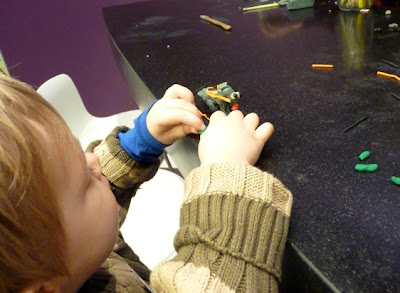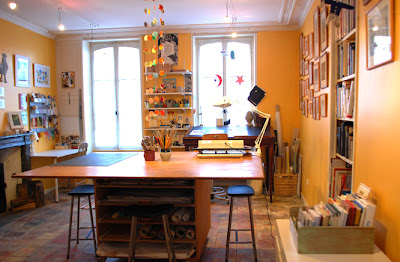It's been a glorious week of blue skies, magnificent sunrises and quiet days. I never loved winter when I lived in California, but here it has become one of my favorite seasons of the year. I have so much time to dream and play in my studio, which is about all I did this whole week.
Meanwhile, Quinn the world traveler (he has visited 9 countries already in his almost 3 years) is in New York City while his father plays in an off-Broadway production of Fragments, by Samuel Beckett and directed by Peter Brook. Read a review from the New York Times here.
The theater and hotel are near Central Park, so Quinn is spending lots of time out-of-doors in the glory of a late New England autumn.
Jos has days free to explore the park with Quinn. Emily has been helping teach a workshop at the theater.
Quinn had heard about the famous dinosaur bones in the Natural History Museum and he was really anticipating this visit. He asked me before he left if he was going to be allowed to feed the dinosaurs. I told him the problem was that they have no tummies.
Emily and James have always loved their uncle Andy, who lives in Rochester. He is the youngest brother of their late father, who died when they were about Quinn's age. Andy has many of the qualities their father had, so it is no wonder that he and his wife Marsha have always been dear to them. When they came to see the show, Quinn took to Andy and Marsha right away as well.
Quinn is enjoying the sights and sounds of the city. He especially likes the taxis. He got his own miniature version. When taken to Times Square he did pronounce it as boring, however.
In the park is a children's museum where there are lots of activities. I loved this picture of Quinn making a little sculpture.
So wonderful!
Emily and Quinn fly home tomorrow and we will spend next weekend with them. Jos stays on until the end of next week.
***
I had an energetic week in the studio, beginning with reorganizing and cleaning the space itself. It took me two full days to break down the boutique (which I do every winter), rearrange my furniture, scrub everything from top to botton, shuttle books up and down stairs to make room for even more books and in general set the stage for a productive winter season next to the cozy fireplace.
I experimented with a lot more chine collé, this being only one of many we printed. It is a fun process that deserves a lot more exploration.
I have hundreds of family photos and I always enjoy making little portraits of ancestors, which I also indulged myself in this week. Not one of these folks is still alive today.
I continued on my nature journal as well, though finding nature inside rather than out.
Here is a drawing some of the shells I collected during summer outings.
Towards the end of the week we decided to drag our photo etching box out of retirement in our garden shed and try once again to make it work. Rick made this box to expose photo-sensitive plates a couple of years ago and at first it seemed to work very well. We really enjoyed the process, even having a class one summer. All of a sudden it seemed to go all wrong and we couldn't get our plates to develop correctly. We didn't change our process but the images were not turning out with any contrast. The plates are fairly expensive, about 10€ a piece, so after spending a tidy sum trying to get a good result and failing, we retired our box altogether. We assumed that we had a bad batch of plates, that they had already been exposed to light, but our provider would not confirm a problem on their side, so we just shelved the whole process. I did buy a couple more several months ago since they were on sale and I've had them in my drawer since. Georges, who uses a much more expensive and professional process than this one (you can see it here) inspired us to try again. Here's the process step-by-step:
You begin with a photo and create a black and white positive on transparent film.
This will be exposed onto a photo-sensitive plate with this box, which shines a UV light onto the plate through the transparency.
The plate is posed on a backing board, the transparency is placed on top and a piece of glass is placed over this and squeezed in place with clamps to hold the plate and transparent image together snugly.
The UV light must be turned on before the plate is placed inside and needs to sufficiently warm up.
The plate is placed in the box and left to expose for three minutes. This is more or less like exposing a solar plate, but faster.
The transparency is removed and a half tone screen is placed over the plate in its place and again exposed to the light, this time for a minute and a half. This adds the half tone dots which allows for better printing of dark areas, like in a newspaper before the digital revolution.
The plate is developed in clear warm water. This is a completely non-toxic technique. We can already see here that this is working! The plate is a good one...much to my pleasure and disbelief.
The plate is dried with a hair dryer so that water streaks from the development process can be eliminated. This is actually the trickiest part of the whole thing.
The plate is put back in the box for a few minutes further harden the emulsion for printing. The edges are then beveled to prevent cutting the paper or press blankets.
Here's the finished plate. We haven't printed it at all yet, as it has to rest for a while but we can more or less tell that it has all developed rather well. Hopefully I can show you printed results next week.
Another week come and gone. Holiday thoughts are starting to bubble up.
Enjoy your last days of November.

























Love the cabbage! And still loving your new prints. really nice.
ReplyDeleteHello Nancy,
ReplyDeleteQuinn looks to be having a wonderful time in the Big Apple. I love NY in the Fall, especially Central Park.
I agree with you about winter...LOVE IT!!! I relish the down time it provides.
Your print of the cabbage came out beautifully!
We are getting ready for Thanksgiving..just took a pumpkin pie out of the oven. The house smells of cloves and cinnamon.
Getting ready for my Holiday Open House at my two shops and busy planning Annie Sloan Chalk Paint workshops in January.
Enjoy your quiet weekend my friend.
Janet xox
These blogs make me so lonely for you!
ReplyDeleteHi Nancy!
ReplyDeleteI've just caught up with your latest post as well as this one.The cabbage plate has printed beautifully - well done! What sort of plates do you use? I have done a little work with solarplates, but I like the fact that with your system the exposure time is set at three minutes. Does that mean there is no testing or other mucking around? It's not that difficult with solarplates but I found that I did have to do a few tests for each image, and that means using up more plate, which as you said is not cheap.
Your winter inside with lots of time for art making sounds wonderful! I'm rather envious! Have fun!